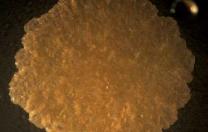Mycobacterium tuberculosis remains a black box, and scientists have begun to wonder if it operates by a different set of biological rules than those they are familiar with. Last year, the director of the National Institutes of Health awarded a special “New Innovator” grant to a young Harvard School of Public Health (HSPH) faculty member, Sarah Fortune, to investigate this possibility.
Fortune, an assistant professor of immunology and infectious diseases, asks how TB escapes detection by the immune system—a fundamental question with ramifications that extend all the way to the structure of treatment programs, whose difficulty reflects the complex biology of the bug.
“The canonical model,” she says, “is that TB goes into the macrophage [a form of white blood cell], is sequestered, becomes dormant and drug resistant, and lives there protected forever.” But other bacteria, including those that cause salmonella, legionnaires’ disease, and typhoid fever, have “at least conceptually similar lifestyles in a protective vacuole in a macrophage,” and are treatable. Typhoid, for example, can be cured with ciprofloxacin in three days. With TB, she says, “It takes at least six months—nine if the case is latent.”
Furthermore, a typical macrophage lives only about two years, while latent TB can persist for 30. This implies that the bacteria periodically move on to other cells to escape the host animal’s immune response. “Malaria does something similar on a much smaller time scale,” Fortune explains. “You get waves of disease when the malaria is escaping and replicating, and then it becomes quiescent, whereas with TB, it is not clear that there are real expansions and contractions of populations.” The implication is that a very few bacteria become very adept at surviving in the host across generations.
The grand problem with that possibility, Fortune explains, is that it flies in the face of traditional evolutionary theory. Typically, bacteria resist host immune defenses or drug therapies by random mutation within large populations. Those few individual bacteria with genetic changes that make them resistant survive these selective pressures and found new populations. If their bacterial progeny face new pressure—a second antibiotic, for example—there is a chance, if they are numerous enough, that one or more will carry an additional mutation conferring resistance to the second antibiotic. But genome sequencing of drug-resistant TB strains carried out at the Broad Institute (in a project co-led by HSPH associate professor of epidemiology Megan Murray) suggests that TB has little genetic plasticity—all strains seem to share a basic blueprint—and doesn’t mutate especially quickly. “Is it mathematically even possible,” Fortune asks, “that a few bacteria that mutate very slowly could actually develop resistance to eight antibiotics?” (as strains of extensively drug-resistant TB repeatedly do). This suggests TB may use some other strategy to survive.
One possibility is horizontal gene transfer, in which whole “cassettes” of genes that confer resistance to environmental pressures are exchanged among bacteria. Many bacteria do this, including at least one species of Mycobacterium.
Fortune has chosen to investigate a different possibility. If there are generations of bacteria living in humans that somehow become drug resistant, but their numbers are too small to achieve this through random mutation and selection, she asks whether the ability to adapt to a changed environment can be acquired and then passed from one generation of bacteria to the next in ways that are not genetic. Mechanisms of “post-genetic” inheritance have been described in animals, plants, and fungi, and Fortune hopes to discover if TB uses them, too. That could explain the microbe’s ability to persist latently for decades even in people with healthy immune systems.









